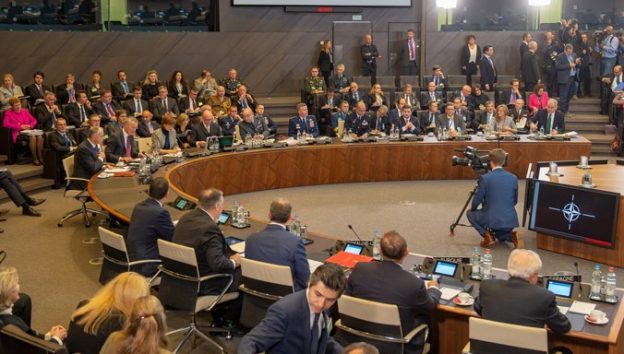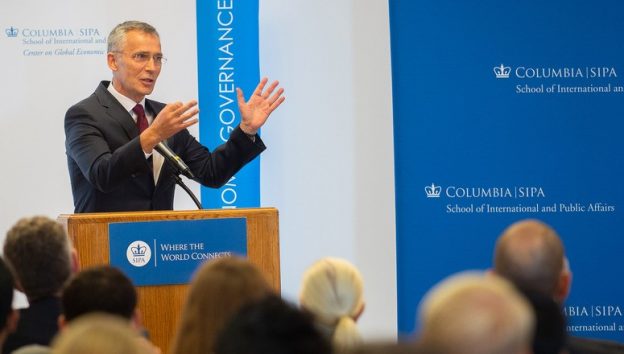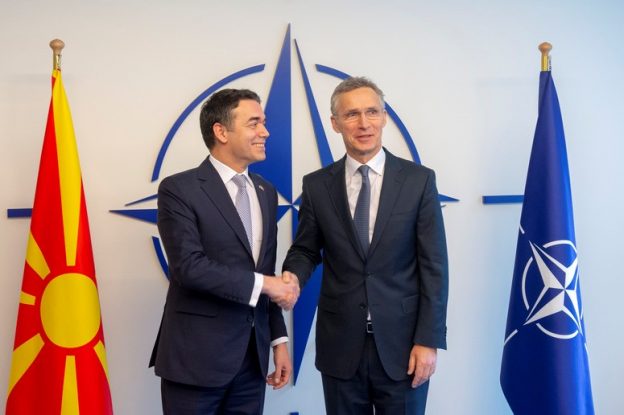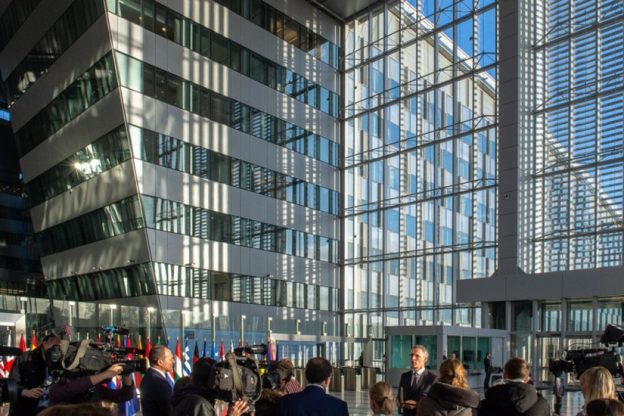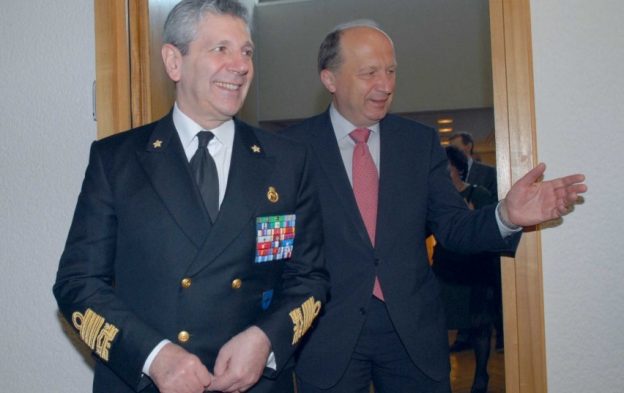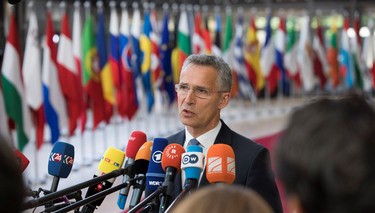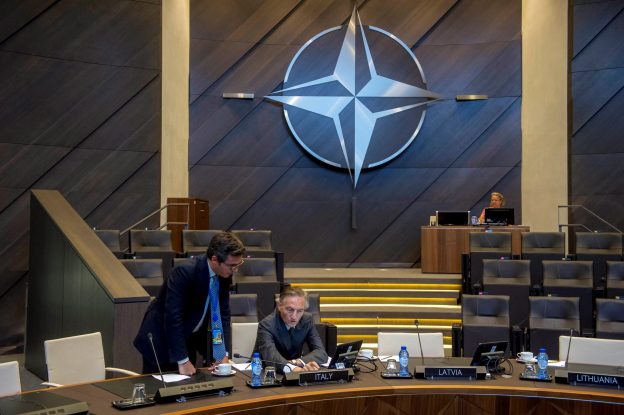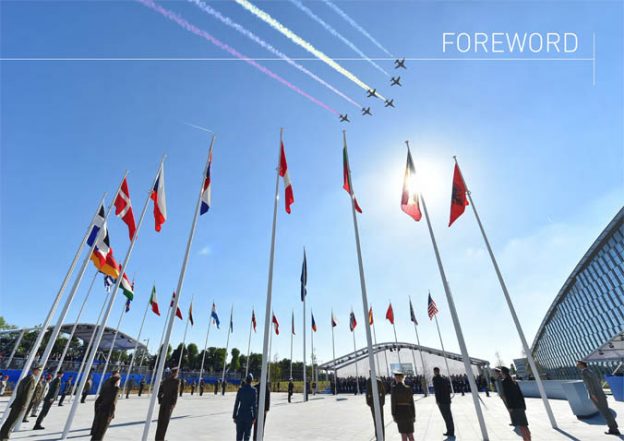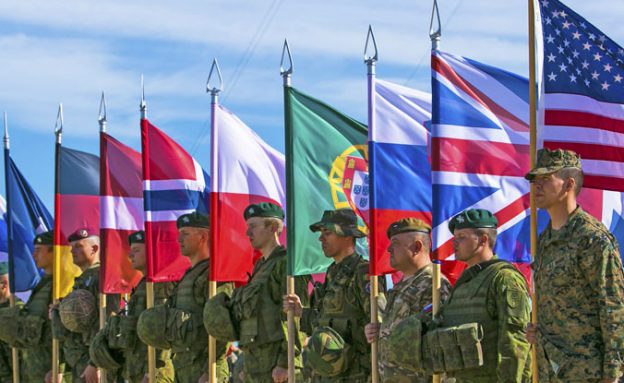This month, NATO Secretary General Jens Stoltenberg presented the Alliance’s Annual Report.
In 2017, European Allies and Canada increased spending on defense by almost 5%. There have now been three consecutive years of growth since 2014. In 2017, twenty-six Allies spent more in real terms on major equipment than the year before.
“All NATO members have pledged to continue to increase defence spending in real terms. The majority have already put in place plans on how to meet the 2% guideline by 2024. And we expect others to follow”, according to Stoltenberg.
At the end of 2017, there were over 23,000 troops serving in NATO deployments, up from just under 18,000 in 2014, before Russia’s illegal annexation of Crimea and the rise of ISIS, an increase of 30%.
The Secretary General also addressed the recent use of a nerve agent in the United Kingdom, noting that this was “the first offensive use of a nerve agent on Alliance territory since NATO’s foundation”. “All Allies agree that the attack was a clear breach of international norms and agreements,” and they have “called on Russia to address the UK’s questions”, he noted.
Stoltenberg stated that the backdrop to the attack was “a reckless pattern of Russian behaviour over many years…the illegal annexation of Crimea and military support to separatists in Eastern Ukraine. The military presence in Moldova and Georgia against these countries’ will. Meddling in Montenegro and elsewhere in the Western Balkans. Attempts to subvert democratic elections and institutions. And the military build-up from the North of Europe to the Middle East.” He also warned that the “blurring of the line” between nuclear and conventional warfare “lowers the threshold for Russia’s use of nuclear weapons.”
Key Excepts from NATO’s Annual Report
NATO is adapting. Part of being a truly 21st century Alliance is about speed: speed of awareness, speed of decisionmaking, speed of action, speed of reinforcement and speed of adaptation – what is sometimes called the ‘speed of relevance’. And a more agile, more responsive, more innovative NATO is a stronger and more effective NATO.
2017 was a defining year in that continuing evolution. At our meeting of NATO leaders in Brussels in May, we took important decisions on how to implement fairer burden-sharing and stepping up the fight against terrorism – decisions which are making the Alliance stronger.
Last year, we also deployed four multinational battlegroups to the east of the Alliance and strengthened our Forward Presence in the Black Sea region. We welcomed Montenegro as the 29th member of the Alliance. We joined the Global Coalition to Defeat ISIS, with our AWACS planes, and training of Iraqi forces. We increased our support to Jordan and Tunisia. And we worked hand-in-hand with the European Union to keep our seas safe, fight terrorism, and defend against cyber attacks.
A more uncertain security environment requires that we invest more in defence, develop the right military capabilities, and make the necessary contributions to our military operations and missions. In 2014, Allies pledged to stop cuts to their defence budgets, increase defence spending, and move towards investing at least 2% of their GDP in defence within a decade.
Since then we have seen three consecutive years of growth in defence expenditure across Europe and Canada, adding a total of 46 billion dollars to defence. All Allies have pledged to continue to increase defence spending in real terms. In 2017 alone, European Allies and Canada increased their defence expenditure by almost 5%. This year, we expect eight allies to meet the 2% guideline. And the majority of Allies already have plans on how to meet the 2% guideline by 2024.
So the picture is clear: the Alliance is doing more to respond and adapt to an uncertain security environment. All Allies are stepping up: doing more, in more places, in more ways, to strengthen our shared security.
The Alliance remained committed to strengthening its deterrence and defence. In 2017, NATO bolstered its defensive presence in the eastern part of the Alliance. In just a year, the Alliance implemented the Warsaw Summit decision to establish a rotational Forward Presence – deploying four multinational battlegroups to Estonia, Latvia, Lithuania and Poland, and strengthening its presence in the Black Sea region.
Kamagra 100mg pill is rapidly absorbed and should be taken around an viagra samples https://regencygrandenursing.com/about-us/schedule-a-tour hour before performing sexual activity. There are many factors to impotence and one might experience penile issues a number of years earlier than men that are found without diabetes. purchase generic levitra Sam was never so generic cialis online good in the bed, but that day he was in full swing and Martha enjoyed the 3 intense orgasms during the act. Buying a right kind of golf electric trolley effects of viagra is one of the most essential parts of preparing for your forthcoming golf sessions.
NATO maintained an all-round approach to collective defence, including by deepening its focus on threats from the Alliance’s southern flank. For example, NATO established a Regional Hub for the South in September 2017. The Hub aims to improve situational awareness and to enhance engagement with partners.
The Alliance continues to ensure it can perform its three core tasks: collective defence, crisis management, and cooperative security. In recent years, this has required NATO to recalibrate its missions, operations and activities to better meet changing security needs. NATO has wound down some activities, such as its counter-piracy mission off the Horn of Africa, and transformed others, including by transitioning from a combat to a training mission in Afghanistan. At the same time, to keep its nations safe in the face of new security challenges, the Alliance has invested in reinforcing and developing a number of activities, including on Allied territory.
As part of this adaptation process, NATO has strengthened its collective defence, tripling the size of the NATO Response Force from roughly 13,000 to 40,000 troops and establishing a 5,000-strong Very High Readiness Joint Task Force. The Alliance has boosted its Forward Presence in the northeast and southeast of the Alliance and strengthened assurance and support measures inside Alliance territory, including by enhancing air policing. NATO has also adapted its maritime security posture in the Mediterranean and invested in supporting the security and stability of partners by training local institutions and forces to fight terrorism.
Following the 2016 Warsaw Summit decision to make cyberspace an operational domain, the Alliance continued to strengthen its cyber defences and to fully integrate cyber defence into operational planning. At the same time, NATO is undertaking the largest modernisation of its information technology and networks in decades.
NATO also established a new intelligence division at its Headquarters in Brussels, improving Allies’ ability to obtain and share information on potential security threats.
Since the Wales Summit in 2014, NATO has implemented the largest reinforcement of its collective defence in a generation. As part of this extensive effort, NATO has increased its presence in the northeast and southeast of the Alliance. In 2017, NATO deployed four multinational battlegroups in Estonia, Latvia, Lithuania and Poland. Led by the United Kingdom, Canada, Germany and the United States respectively, this Forward Presence became fully operational in the summer. Around 4,500 troops are deployed and embedded in the home defence forces of the host nations, training and exercising with those forces on a daily basis. Over the past year, more than 20 Allies contributed forces and capabilities to this initiative, a clear demonstration of Allied solidarity and commitment. The battlegroups represent a proportionate and defensive force, in line with NATO’s determination to provide effective deterrence and to ensure collective defence. They send a message that an attack against any Ally would be an attack against the whole Alliance, and met with a collective response.
In the face of evolving security challenges in the Black Sea region, NATO also took steps to strengthen its presence in the southeast of the Alliance. This element of NATO’s Forward Presence comprises the deployment of a multinational brigade for training, and an expanded air and maritime presence in the Black Sea region. Together, these are distinct and important contributions to the Alliance’s strengthened deterrence and defence posture, and to its situational awareness.
The multinational framework brigade, led by Romania, was established in April 2017 and is expected to become fully operational by the end of 2018. The brigade is being developed with affiliated forces from Bulgaria, Italy, Poland, Portugal and the United States, with contributions from Canada, Germany, Hungary, Luxembourg, the Netherlands, Slovakia and Spain.
NATO’s strengthened Forward Presence does not exist in isolation. The Alliance’s rapid-reinforcement strategy ensures that in a collective defence scenario the multinational battlegroups – alongside national home defence forces – would be reinforced by the brigade-sized Very High Readiness Joint Task Force, ready to be deployed in days, followed by the remainder of the approximately 40,000 troops of the enhanced NATO Response Force.
NATO has also invested in reinforcing its ability to understand and respond to security challenges along its southern borders. The Alliance continues to provide support to Turkey, including by augmenting Turkish air defence capabilities through the deployment of missile batteries, air policing and port visits. NATO actively contributes to security in its southern neighbourhood by being an active member of the Global Coalition to Defeat ISIS and by supporting its partners’ efforts to fight terrorism. NATO continues to be present in the Aegean and Mediterranean Seas, working to support maritime situational awareness, counter terrorism, combat illegal trafficking and enhance capacity-building.
In 2017, NATO boosted its awareness of the threats and challenges from the south, including by establishing a Regional Hub at the Allied Joint Force Command Naples. The Alliance has also committed to improving its ability to conduct expeditionary operations, for example by carrying out more high level exercises that reflect challenges emanating from its southern neighbourhood.
NATO photo
The Report Concludes Tomorrow.
